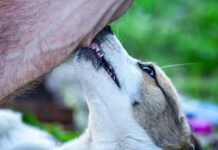Spending time with your dog is one thing. Watching for behaviors that can be incorporated into training is another.
While free time is free for the dog, it’s work for the handler/trainer, requiring focus and attention to detail. Experienced trainers and competitors will notice things that novices won’t, but even if a handler is not actively training a dog, or the dog is best described as a house pet, free time can be an effective tool for better understanding the dog’s interests, temperament, and personality. “That adds balance to any relationship,” says Tanner, “but first and foremost I think it adds depth to a solid training program. You can use what you observe to create a better and more cohesive dog/handler team, with the relationship first and foremost in mind.”
Here are Tanner’s suggestions for beginning a free-time program:
Always work in a safe area with no moving traffic, no other off-leash dogs, no people other than familiar family members, and no opportunity for your dog or dogs to chase wild animals or eat something dangerous. Take time to choose a location before you start. If a remote outdoor area isn’t possible, it can be a borrowed fenced yard or an indoor room or basement. The location should be large enough for freedom of movement and have no training association.
In a multiple-dog household, bring all the dogs, since they are probably accustomed to being together. Working with one dog at a time makes them easier to observe, but that becomes time-consuming. Familial dogs do fine together in free time. You just have to be on your toes as an observer.
Observation Without Direction should be completely free from judgment. If your dog rolls in scat, then you observe. Clothes can be cleaned and baths can be taken. You are gathering information. If you start gasping or re-directing your dogs when they stop-drop-and-roll, you are correcting and training, and it is no longer free time. Be prepared and be open.
If your dog wants to engage you in a game, then play, but don’t start directing. Learn to follow your dog’s lead during free time.
Some days you will come home with great information and other days nothing, just a nice outing. Write notes to yourself. Watching your dog for weeks or months in free time will help you see patterns in behavior, and these are what deserve your attention.
For dogs who are independent or don’t have a strong relationship with their owners, observation should be directed toward what attracts their attention and what motivates them. Example: The moment you take off the leash, your dog runs away and stays away, and the pattern repeats over and over. This should bring up a lot of questions. Does the same pattern happen at home? In the dog park? Does the dog’s leash come off right away and she immediately gets to run, or does the dog pull her owner to the dog park and then get the leash unclipped, and does the leash get put on with a correction once the dog finally comes back?
The goal in a training program would be for the leash to come off and the dog acknowledge the owner before departing. If scent or sound pulls the dog away, or if inconsistent handling drives the dog away, those observations can be incorporated into the training program by providing stinkier treats, squeakier toys, and play every time the leash comes off at home. Leash comes off, stinky liver treat, leash goes back on, leash comes off, boom, stinky liver treats. Leash comes off, game of tug with squeaky toy, leash goes on, game stops, leash comes off, game with tug toy, and so on.
For cautious, worried dogs, free time may be overwhelming. Try for short, successful sessions. Start with 5 to 10 minutes and then leave. Choices can overwhelm dogs who do not have confidence, so they often don’t even try. Just sit tight, or walk around the free area. Don’t say anything; just be neutral and present. It may take time for uncertain dogs to try something out, but once they do and they find that all is good, confidence can grow and the handler can learn by observing.
Be careful not to “direct” an uncertain dog during free time – that’s training! And don’t reassure him by saying things like, “You’re OK, go on, you’ll be fine” – that’s directing! Watch for a nice working tail position, slow easy wag, nice relaxed mouth, light panting, soft or “easy” eyes, sway in the body when walking around, and most important, tiny steps toward exploring on his own.
Study canine body language. Get at least one book, preferably with photos or line drawings, to help you interpret canine signals. The more you observe body language in your dog, the better you’ll become at deciphering subtle signs, and clusters of body movements will speak to you like a book. This is when a free time program wtakes off for any trainer.




